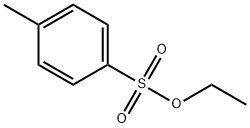Tosyl cyanide
Synonym(s):p-Tolylsulfonyl cyanide;Tosyl cyanide
- CAS NO.:19158-51-1
- Empirical Formula: C8H7NO2S
- Molecular Weight: 181.21
- MDL number: MFCD00009977
- EINECS: 242-849-1
- SAFETY DATA SHEET (SDS)
- Update Date: 2024-10-25 16:21:11

What is Tosyl cyanide?
Chemical properties
White powder
The Uses of Tosyl cyanide
Tosyl cyanide is used in a free-radical cyanation of B-alkylcatecholboranes. Also used as a component in a hetero-Diels-Alder reaction with 1,3-bis-silyl enol ethers leading to 4-hyroxypyridines.
The Uses of Tosyl cyanide
p-Toluenesulfonyl cyanide can be used in:
- The preparation of polyfunctional nitriles.
- Free-radical cyanation of B-alkylcatecholboranes.
- The synthesis of 4-hyroxypyridines by hetero-Diels-Alder reaction with 1,3-bis-silyl enol ethers.
What are the applications of Application
p-Toluenesulfonyl cyanide is used in the preparation of polyfunctional nitriles and free-radical cyanation of B-alkylcatecholboranes
Synthesis Reference(s)
Tetrahedron Letters, 10, p. 3351, 1969 DOI: 10.1017/S0009838800024678
General Description
p-Toluenesulfonyl cyanide is an electron-deficient nitrile. It undergoes hetero-Diels-Alder reaction with silyl enol ether of cyclohexenone to yield hydrolytically sensitive [4+2] adduct. It also undergoes facile [2+3] cycloaddition reaction with azides to form 5-sulfonyl tetrazoles. p-Toluenesulfonyl cyanide also reacts with alcohols in the presence of 1,8-diazabicyclo[5.4.0]undec-7-ene (DBU) or 1,4-diazabicyclo[2.2.2]octane (DABCO) to yield sulfinates.
Properties of Tosyl cyanide
| Melting point: | 47-50 °C (lit.) |
| Boiling point: | 105-106 °C/1 mmHg (lit.) |
| Density | 1.3055 (rough estimate) |
| refractive index | 1.5650 (estimate) |
| Flash point: | >230 °F |
| storage temp. | 2-8°C |
| solubility | Acetonitrile (Slightly), Chloroform (Slightly), DMSO (Sparingly), Ethyl Acetate |
| color | White |
| BRN | 2048159 |
| Stability: | Hygroscopic, Moisture Sensitive |
| CAS DataBase Reference | 19158-51-1(CAS DataBase Reference) |
Safety information for Tosyl cyanide
| Signal word | Danger |
| Pictogram(s) |
 Corrosion Corrosives GHS05  Exclamation Mark Irritant GHS07 |
| GHS Hazard Statements |
H314:Skin corrosion/irritation |
| Precautionary Statement Codes |
P260:Do not breathe dust/fume/gas/mist/vapours/spray. P271:Use only outdoors or in a well-ventilated area. P280:Wear protective gloves/protective clothing/eye protection/face protection. P303+P361+P353:IF ON SKIN (or hair): Remove/Take off Immediately all contaminated clothing. Rinse SKIN with water/shower. P305+P351+P338:IF IN EYES: Rinse cautiously with water for several minutes. Remove contact lenses, if present and easy to do. Continuerinsing. |
Computed Descriptors for Tosyl cyanide
New Products
(S)-3-Aminobutanenitrile hydrochloride 4-Methylphenylacetic acid N-Boc-D-alaninol N-BOC-D/L-ALANINOL Tert-butyl bis(2-chloroethyl)carbamate 3-Morpholino-1-(4-nitrophenyl)-5,6-dihydropyridin- 2(1H)-one Furan-2,5-Dicarboxylic Acid Tropic acid 1-Bromo-3,5-Di-Tert-Butylbenzene S-2-CHLORO PROPIONIC ACID ETHYL ISOCYANOACETATE 2-Bromo-1,3-Bis(Dimethylamino)Trimethinium Hexafluorophosphate 4-IODO BENZOIC ACID 3-NITRO-2-METHYL ANILINE 1-(2,4-DICHLOROPHENYL) ETHANAMINE (2-Hydroxyphenyl)acetonitrile 4-Bromopyrazole 2-(Cyanocyclohexyl)acetic acid 4-methoxy-3,5-dinitropyridine 1-(4-(aminomethyl)benzyl)urea hydrochloride 2-aminopropyl benzoate hydrochloride diethyl 2-(2-((tertbutoxycarbonyl)amino) ethyl)malonate tert-butyl 4- (ureidomethyl)benzylcarbamate Ethyl-2-chloro((4-methoxyphenyl)hydrazono)acetateRelated products of tetrahydrofuran








You may like
-
 p-Toluenesulfonyl cyanide 95% (GC) CAS 19158-51-1View Details
p-Toluenesulfonyl cyanide 95% (GC) CAS 19158-51-1View Details
19158-51-1 -
 Tosyl cyanide 95% CAS 19158-51-1View Details
Tosyl cyanide 95% CAS 19158-51-1View Details
19158-51-1 -
 p-Toluenesulfonyl cyanide CAS 19158-51-1View Details
p-Toluenesulfonyl cyanide CAS 19158-51-1View Details
19158-51-1 -
 1975-50-4 98%View Details
1975-50-4 98%View Details
1975-50-4 -
 2-HYDROXY BENZYL ALCOHOL 98%View Details
2-HYDROXY BENZYL ALCOHOL 98%View Details
90-01-7 -
 2-Chloro-1,3-Bis(Dimethylamino)Trimethinium Hexafluorophosphate 221615-75-4 98%View Details
2-Chloro-1,3-Bis(Dimethylamino)Trimethinium Hexafluorophosphate 221615-75-4 98%View Details
221615-75-4 -
 14714-50-2 (2-Hydroxyphenyl)acetonitrile 98+View Details
14714-50-2 (2-Hydroxyphenyl)acetonitrile 98+View Details
14714-50-2 -
 118753-70-1 98+View Details
118753-70-1 98+View Details
118753-70-1